Article mis à jour le 3 Jan 2024
Road trip in Namibia : what to do ?
My trip to Namibia was clearly one of the most beautiful of my life. This destination is extraordinary… Its fauna, its flora, its diverse landscapes : everything was an excuse to marvel. Beyond its beauty, Namibia is a country without mass tourism and with a low population density. In the heart of the savannah and its deserted expanses, I felt very special emotions. In this article, I take you on a journey through my happy memories… Let’s get started with the itinerary of my 11 days road trip in Namibia !
Before I start telling you about my trip to Namibia, here are a few pointers to help you get organised :
- For practical information : when to go to Namibia, the budget for this trip, safety, what clothes to wear for the road trip, and so on. See the end of this article (click to go there directly).
Road Trip itinerary : what to do in Namibia ?
I went on an 11 days road trip in Namibia ! I’ll talk in detail about the budget for a road trip in Namibia at the end of this article.
During this trip, I think it’s cool and really reassuring when you’re travelling with girlfriends that other travellers are doing the same tour as you. What’s more, it’s a great way to meet new people, and that’s what happened on this trip. The bonds forged with the other travellers inevitably helped to make this road trip to Namibia exceptional. So, if you’re passing through, I’d like to give you a big kiss ! ♥️

Day 1 : Arrival in Namibia
As you step off the plane, you will take your first steps into Namibia at Windhoek’s Hosea Kutako International Airport.
Your first night will be spent in the heart of the capital in a comfortable hotel. During my week, we stayed at the Tenbergen Pension Hotel and it was great to be able to rest after the flight ! Be aware that some hotels and campsites are subject to change depending on availability or the season, but the agency will make sure to maintain the same quality for your stay.
There’s not much to do in Windhoek. So take the opportunity to relax and dine at Joe’s Beerhouse, which is an institution. To get there, you can book a taxi with the hotel. Firstly, the decor and atmosphere are very nice, and secondly they serve original dishes such as zebra… Well, I went for the vegetarian burger which was delicious !

Day 2 : What to do in Namibia ?
During this itinerary, you will see the diversity that Namibia has to offer. In just a few kilometres, you can change the landscape completely. That’s why I particularly enjoyed driving on its roads ! Incidentally, I’ll tell you about driving on the left and its particularities at the end of the article, in the practical info section.
🚗 Picking up your 4×4 with roof tent
To begin with, you’ll be taken by shuttle bus to collect your car and house for the week. The roof tent has been very comfortable for two to sleep in. Sleeping bags and pillows are provided. You’ll find a fridge in your boot, plus everything you need for cooking, eating and washing up.
Once you’ve collected your vehicle, head to the SPAR supermarket indicated on the app to do some shopping. And off you go on your adventure !
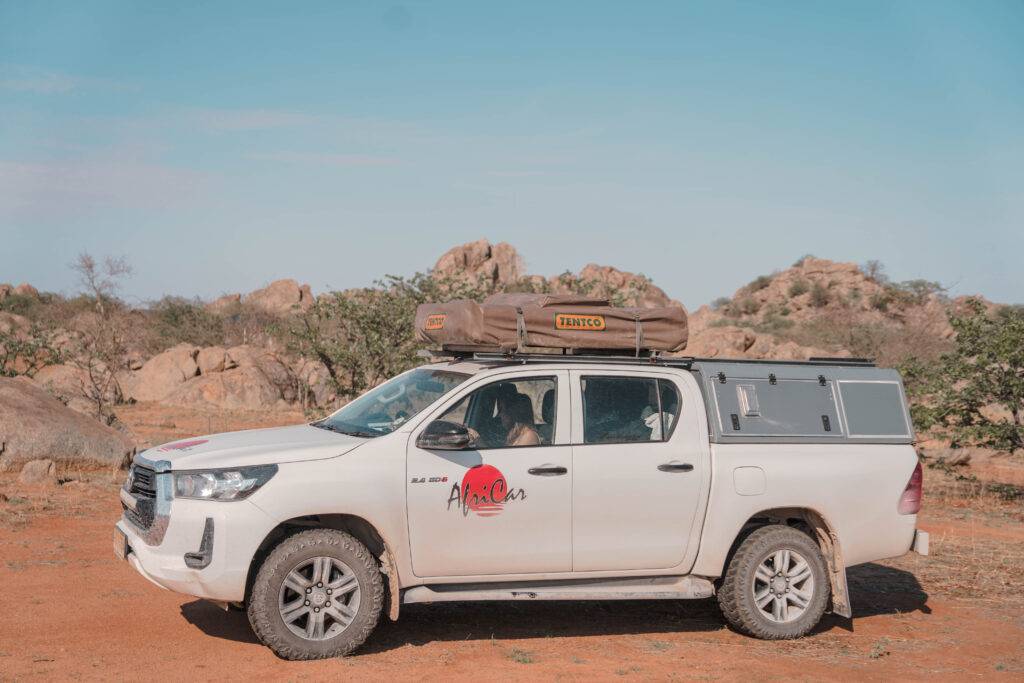
➡️ Drive to Okonjima Nature Reserve
For this first night, you will sleep in a campsite in the heart of the Okonjima Nature Reserve. It is renowned for its cheetah and leopard conservation.
If you don’t arrive too late, you can also visit the village of Ombu to discover the culture of the Ovaherero, an indigenous people of Southern Africa. Visits are available between 10am and 4pm for €20 per person (N$400).
→ Night and day safaris are available at Okonjima lasting around 3 hours. You can book some with the person who will welcome you at the reserve gates. However, I’d advise you instead to take the very early drive to Etosha the next day. You’ll see a lot more animals there !
Days 3 to 4 : Etosha National Park safari
Between Okonjima and Etosha, allow around 3 hours by car.
📍 Cheetah Conservation Fund
You can make a detour to the Cheetah Conversation Fund, to see rescued cheetahs and learn more about the work of this institution, which aims to preserve the species.
→ You should know that Namibia is home to the largest cheetah population in the world. Unfortunately, this cat species has been hunted a lot by man and still is. In 1900, for example, there were over 100,000 cheetahs in the world. Today, there are just 7,500, 4,000 of which can be found in Namibia.
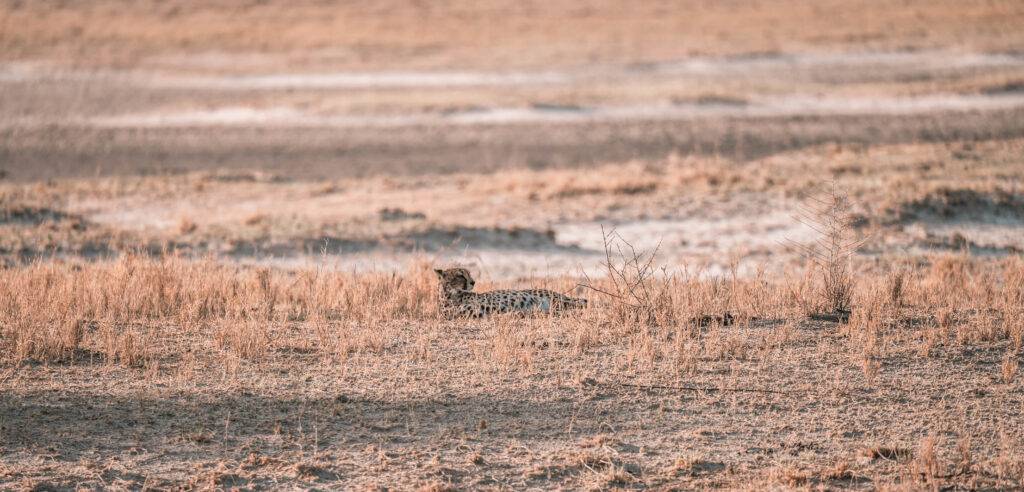
🍔 Lunch stop in Otjiwarango
On the advice of the sacred road book, we stopped for lunch at Memoirs Bar & Restaurant. The terrace was nice with good food and reasonable prices !
There were other suggestions for stops in the itinerary, but we didn’t make them. We preferred to get to Etosha as early as possible. All this to say that you are really free to do what you want on this trip. Only the camp sites are imposed as reserved for you.
🦁 Arrival at Etosha National Park
For these next two nights of the Namibia road trip, you will sleep in Etosha National Park. One night in the east, one night in the west. This salt marsh of around 20,000 km2 is home to no fewer than 114 species of mammal and over 300 species of bird. You may be lucky enough to spot the famous Big Five during your visit.
The Big Five are the elephant, lion, buffalo, leopard and rhinoceros. They are the emblem of safaris and were originally categorised as such for their hunting difficulty.
→ Etosha access : you will need to pay the national park entrance fee for the 2 days, corresponding to N$700 (around €43) for 2 people. Make sure you keep your proof of payment, as you’ll be asked for it when you leave the park !
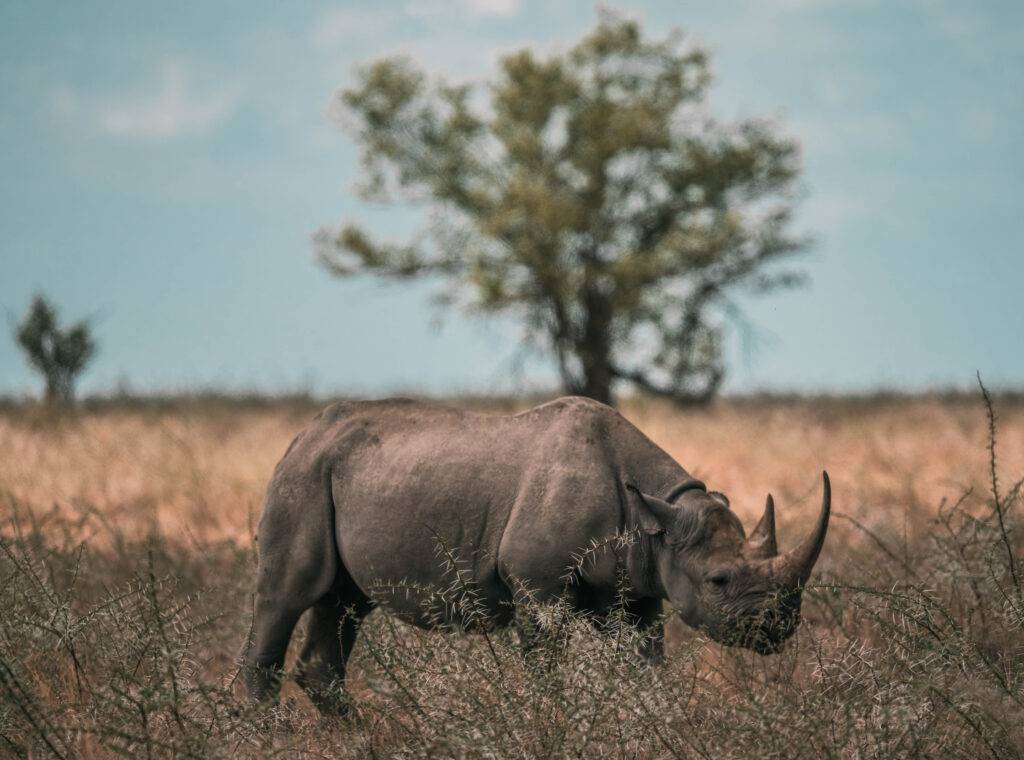

💌Safari activity in Etosha, a must on a Namibia road trip
You can book a sunrise safari excursion with a local guide. I advise you to book this incredible experience ! Beyond that, sunrise is magical in Etosha. It’s a great time of day to watch the animals and, if you’re lucky, some hunting scenes between predators and prey.

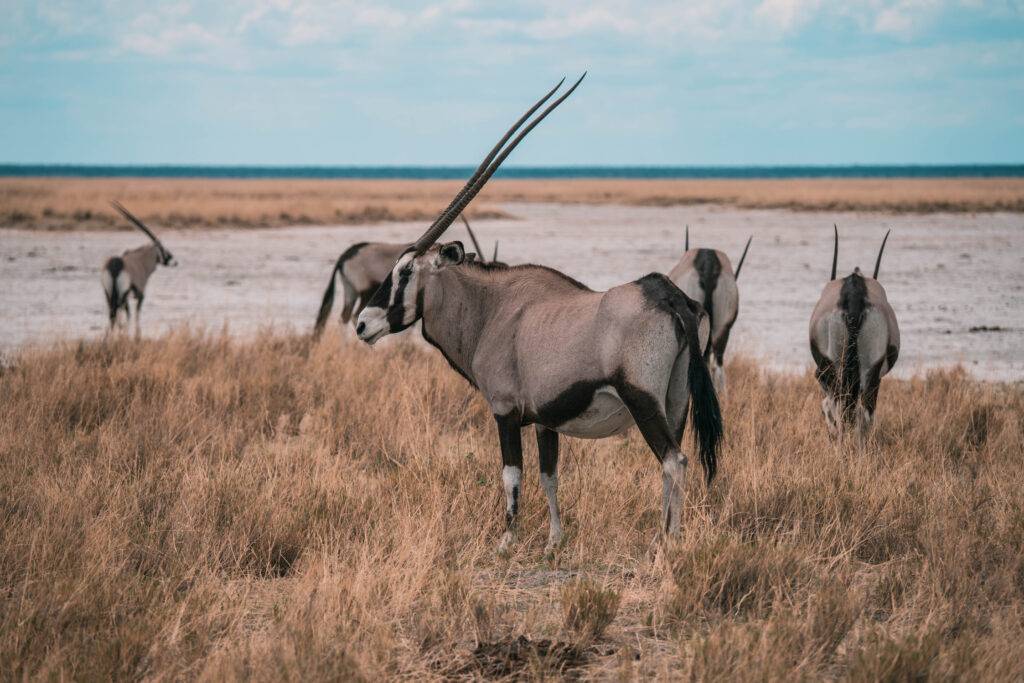
🐘 How do you go on a self-guided safari in Namibia ?
Having loved my Tanzania safari experience, I was really looking forward to seeing what it was like to do one completely on my own, without a guide. Well, I found it incredible! I find the adrenaline increases tenfold when you manage to find lions, for example. 🤩 Many of you have asked me about the safety of the Etosha safari. Don’t worry, you risk nothing if you don’t get out of your vehicle !
To eat, several picnic areas are provided and indicated on the signs. Plan ahead the day before and have something ready for lunch the next day so as not to waste any time. There are also toilets, but unfortunately the cleanliness of the area leaves a lot to be desired.
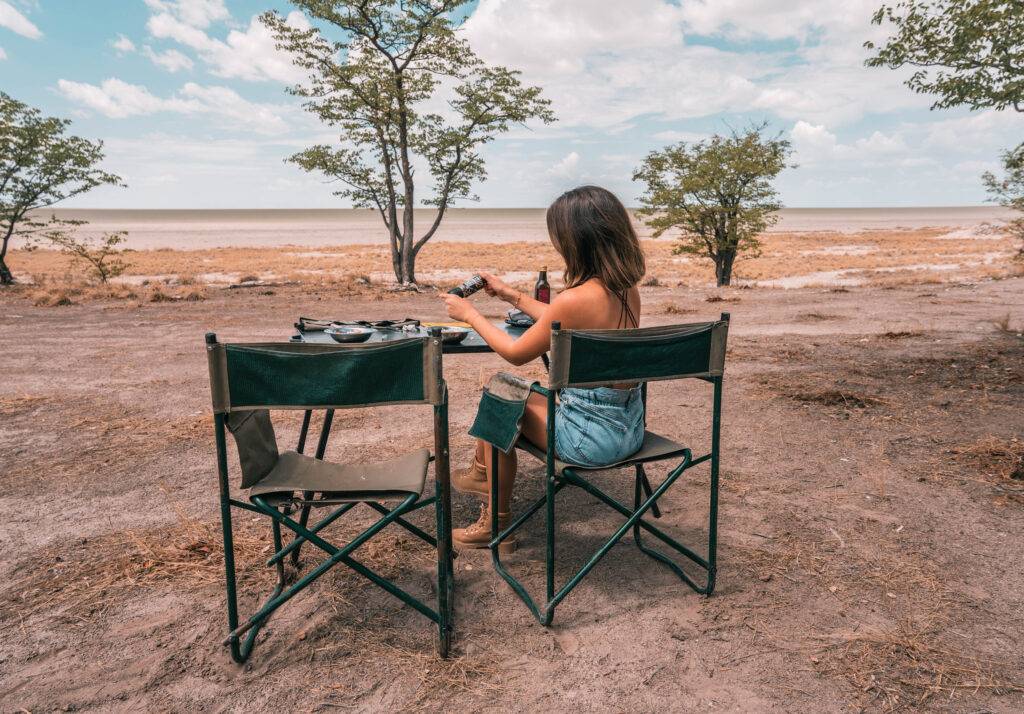

How can you spot animals on safari without a guide ?
The golden rule is to stay close to waterholes. Animals regularly come here to drink! So I advise you to use the Satellite feature in Google Maps to find them, and to head for those where there are paths/roads leading to them. Some of the best spots are marked on the map, so zoom in to find them. Once you’ve reached them, be patient : switch off your engine and observe.
Don’t hesitate to leave the main road when there are paths on either side ! Also, look out for parked vehicles: generally speaking, if people are parked, there’s something to see.
We were lucky enough to come across a family of lions. They were very close to our car and we were alone. It was an incredible experience, a suspended moment that we’ll never forget… 🤩 Don’t forget to take binoculars for your safari !
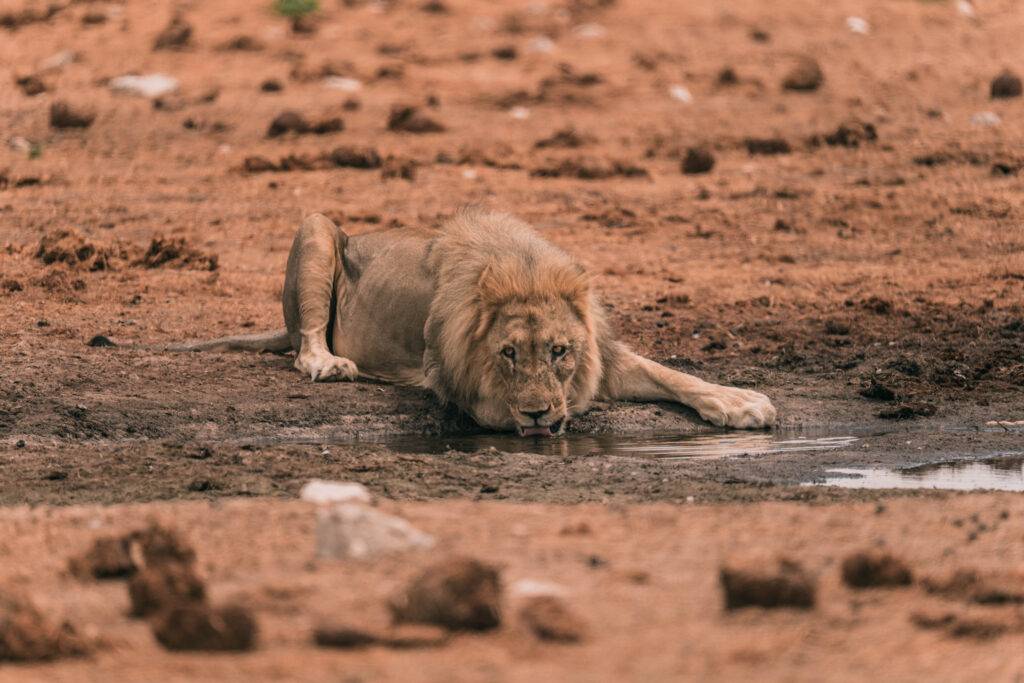
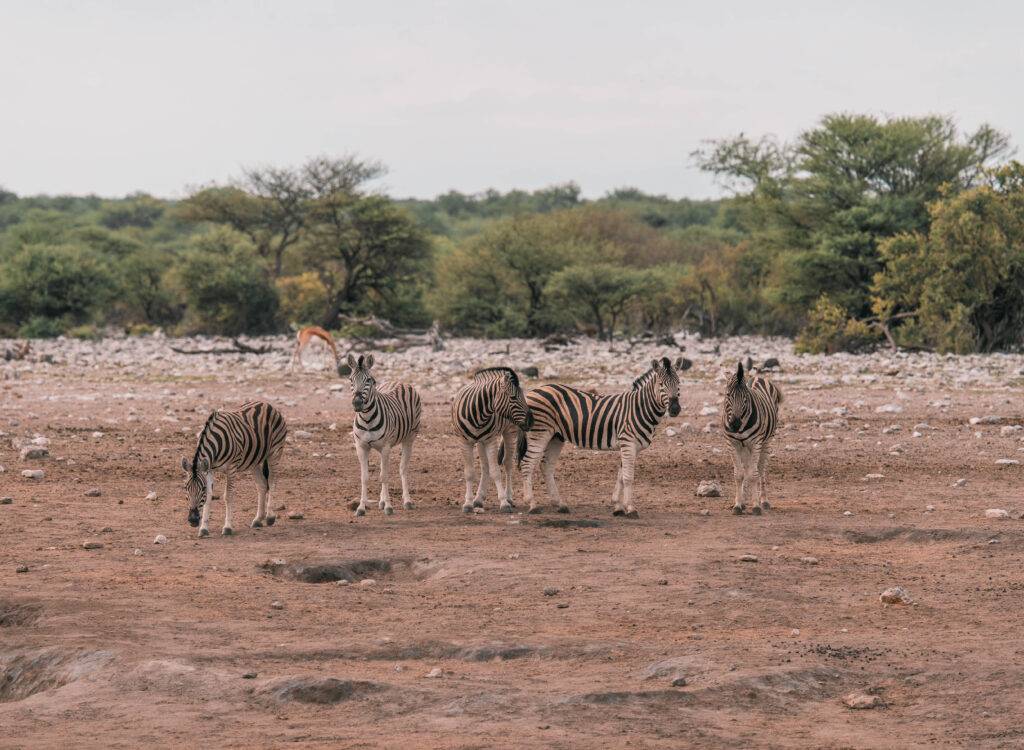
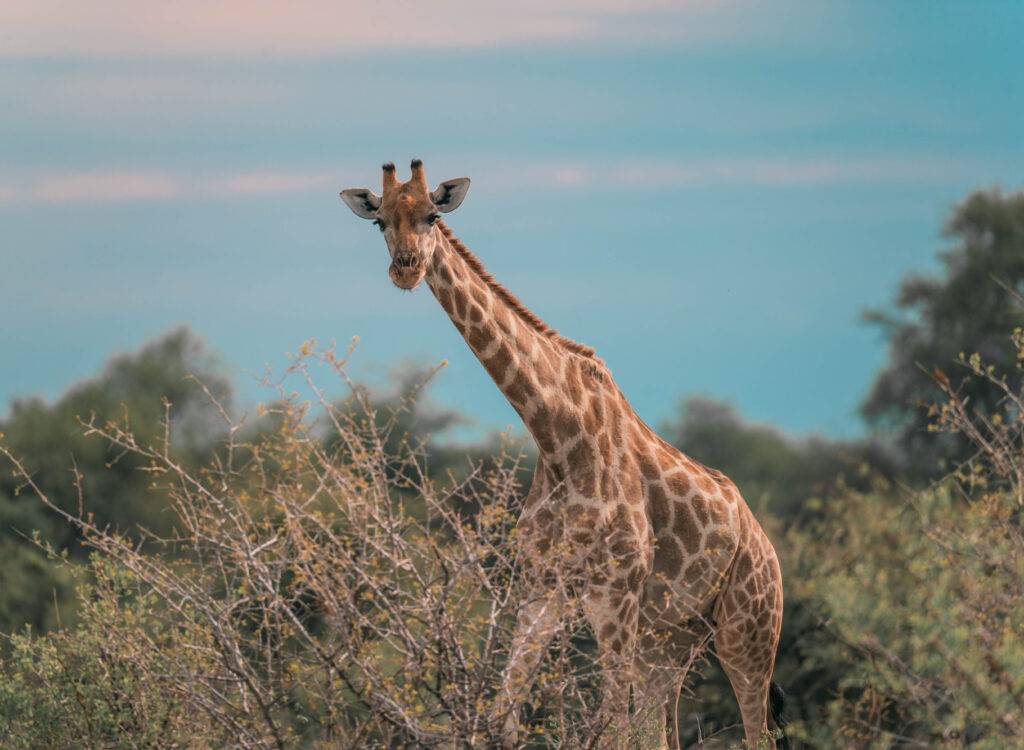
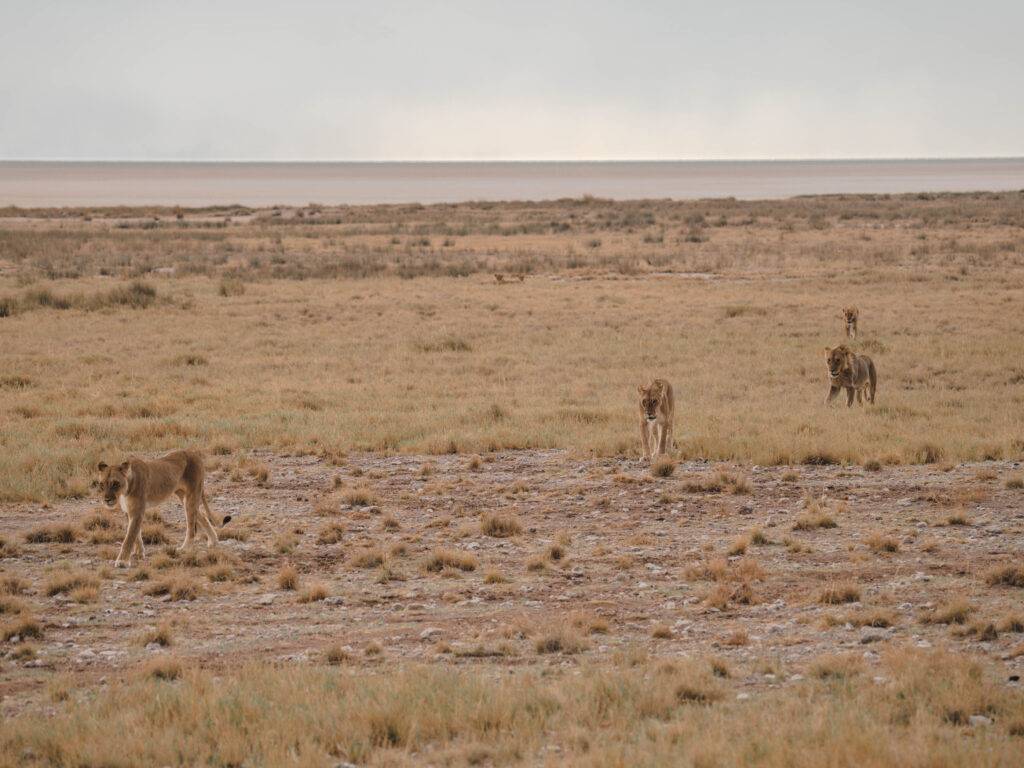

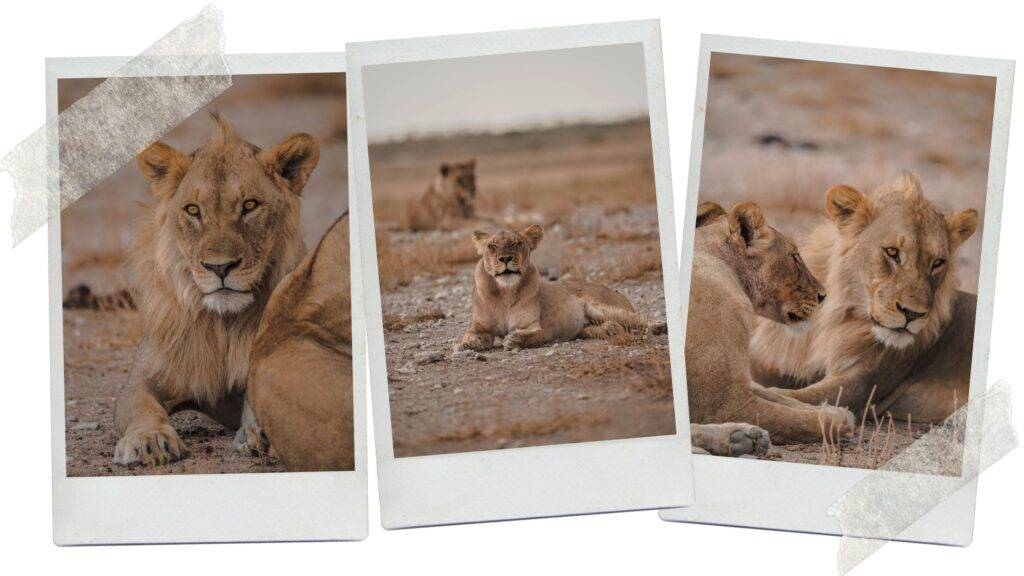
Day 5 : Towards the Grootberg Plateau
This morning, you can get up early to enjoy a final safari in Etosha ! Alternatively, you can head straight for the road. There’s a petrol station just outside Etosha where you can fill up your tank. Just remember to do so when you’re half full, as there are many areas without petrol stations in the country.
✨ Grootberg
In the Kunene region lies the Grootberg plateau, home to some magnificent scenery. The Khoadi Hoas reserve is located here and is used to reintroduce wild animals such as lions and oryx. Animals can be everywhere in Namibia, which is why you should avoid night drives and not drive when it’s dark.
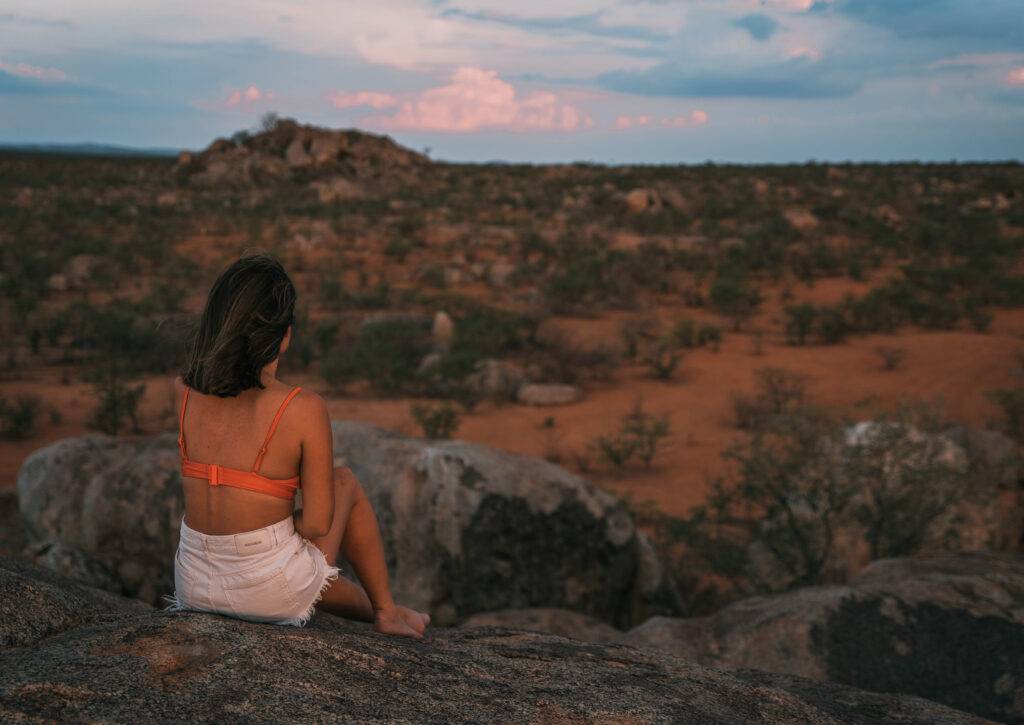
📍 Relaxing at Hoada Campsite
After these two intense days on safari, it’s time to relax a little and the campsite chosen is the perfect place ! You can enjoy a small swimming pool with a splendid view over the valley. Don’t miss the sunset, which was one of the most beautiful I’ve ever seen. The ideal spot is to climb onto the rock overlooking the pool area, but don’t hurt yourself in the process.
Please note : there is no restaurant here, so make sure you have enough food to eat in the evening.

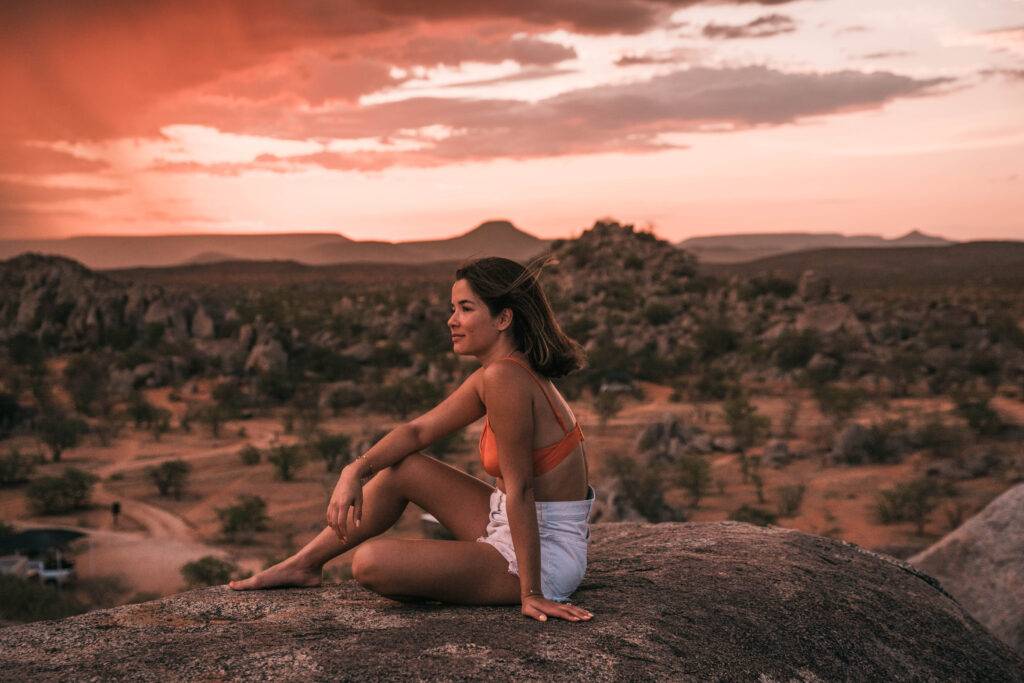
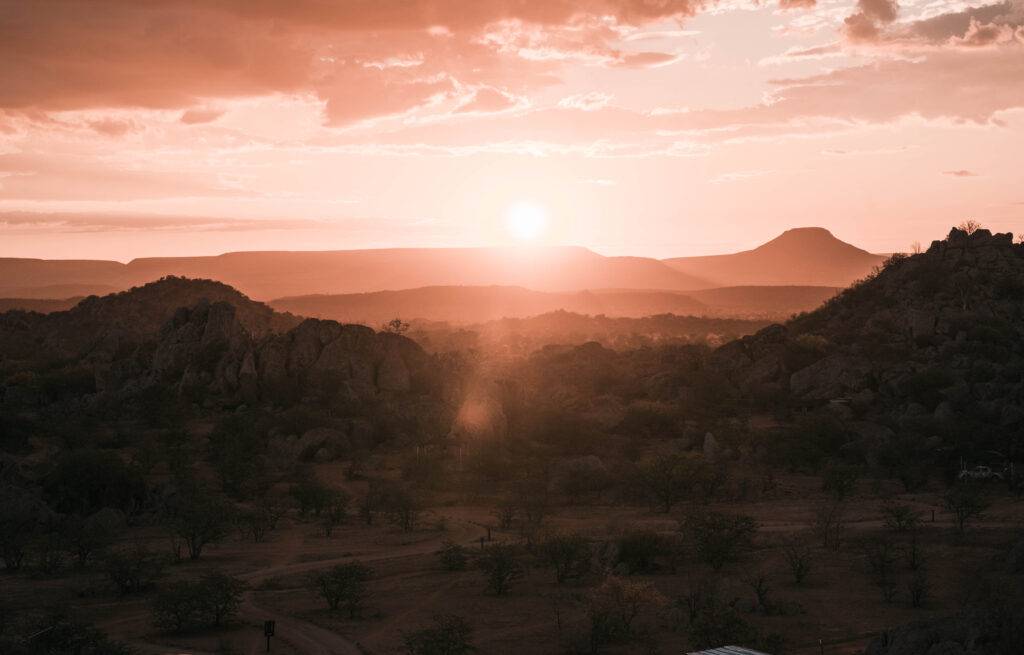
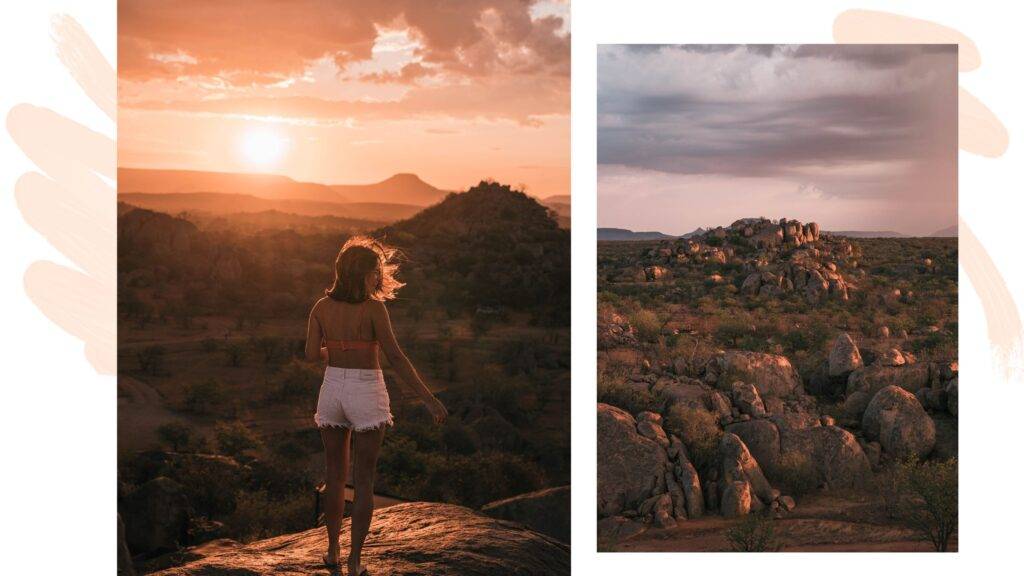
Day 6 : Through the Namibian landscape…
You’ll be doing a lot of driving on this day, as you’ll have to cover around 350 km to reach the campsite for the evening. During this time, you’ll want to stop every 10 minutes on the road because the views are so splendid !
Namibia is a sparsely populated country, with very few vehicles. Although Namibia is 1.5 times the size of France in terms of surface area, there are no more than 2 million inhabitants. It is the 2nd most sparsely populated country in the world.
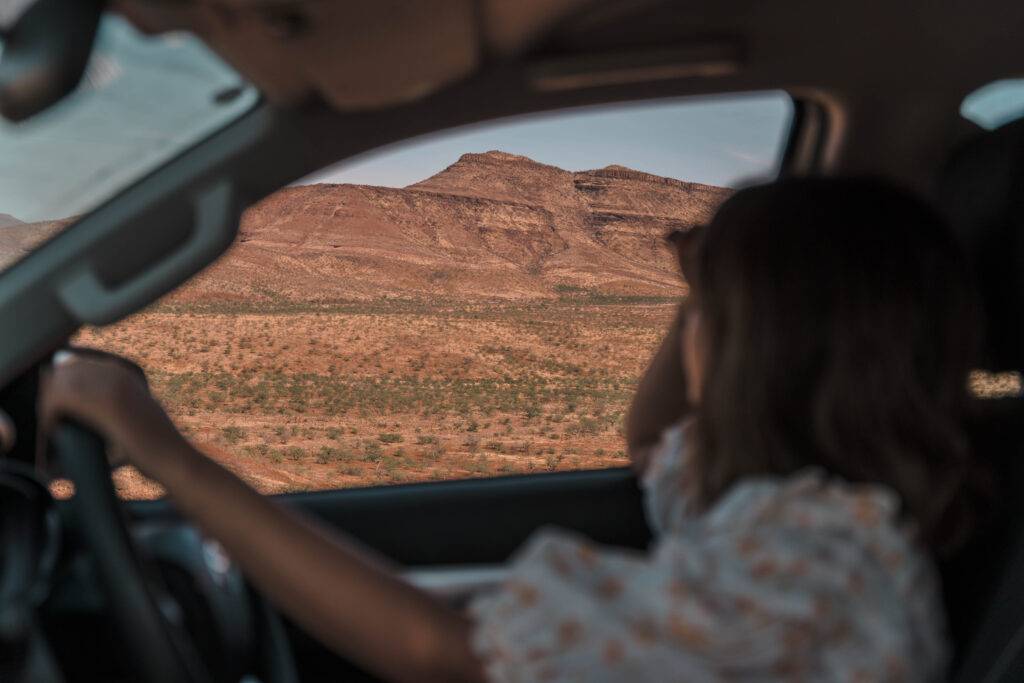
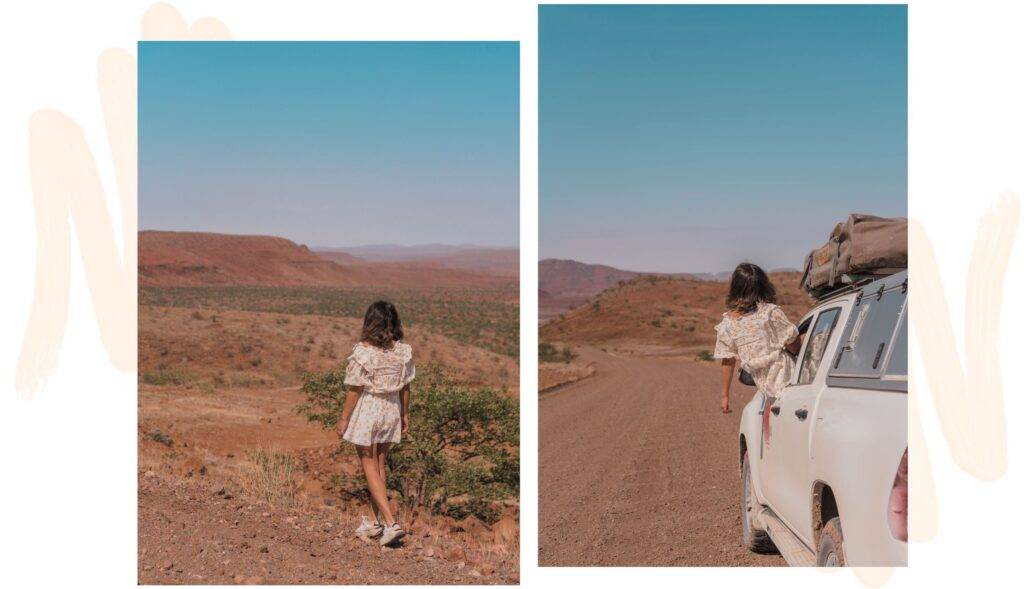
📍 Twyfelfontein archaeological site
To stretch your legs, you can stop off for a short one-hour walk at the Twyfelfontein archaeological site, a UNESCO World Heritage Site. Here you can admire engravings dating back to prehistoric times.
→ Access : compulsory guided tour costing N$250 per person (≈ €15).
My tip : it can get extremely hot in Twyfelfontein. As an example, it was 38°C when I visited. Take plenty of water (there’s a refreshment bar on site if you need it) and something to protect your head from the sun. Be sure to check the weather forecast before you go, as I would advise against it for people with a weak constitution.


😴 Overnight in Spitzkoppe
I’m going to ramble on throughout this article, but it’s not my fault that Namibia is so beautiful ! 😂 Again, you’ll see some stunning scenery at Spitzkoppe. The rock formations, characteristic of this place, are spectacular.
For this night, you’ll sleep in a site camp at the foot of the mountains to visit the site the next morning. The sunset and sunrise are perfect for filling your eyes with glitter ✨.
On the way to Spitzkoppe…
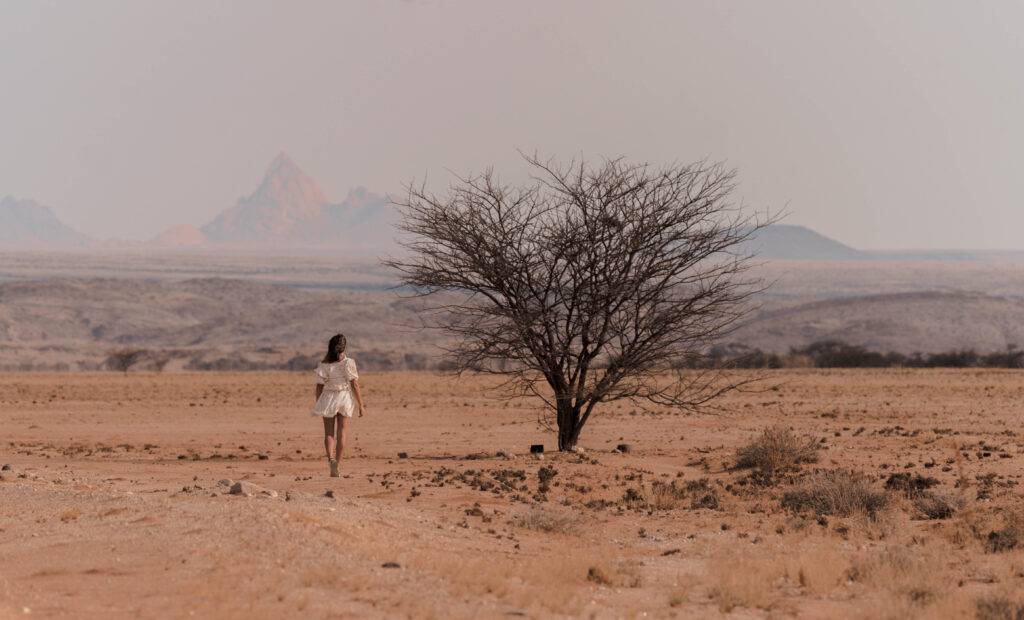
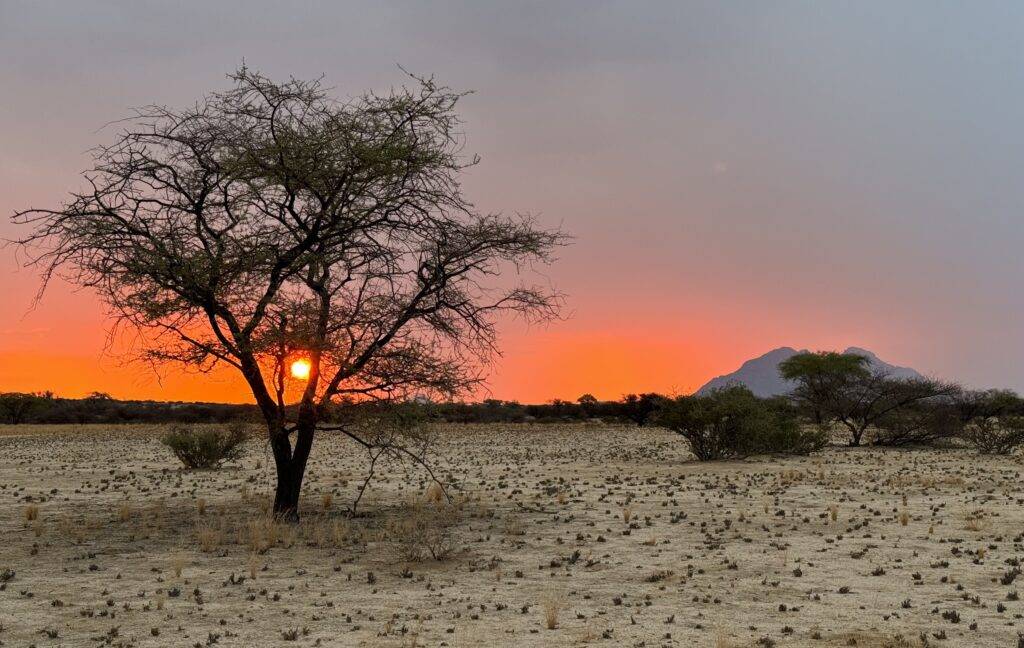
Day 7 : Road trip in Namibia, ocean side
📍 Visit Spitzkoppe
Are you ready to discover a setting worthy of the great American West ? With its ochre-coloured reliefs and natural arches, you’d really think you were there !
Spitzkoppe, in the Namib Desert, is a remarkable site that’s a must-see. Its highest peak is 1,730 metres above sea level. You can drive around the park and park in several places to see the different viewpoints. Longer hikes are also possible. If you’re keen on climbing, you can also do it at Spitzkoppe ! At the visitor centre, you’ll be given a map showing everything there is to see and do. Allow half a day on site.
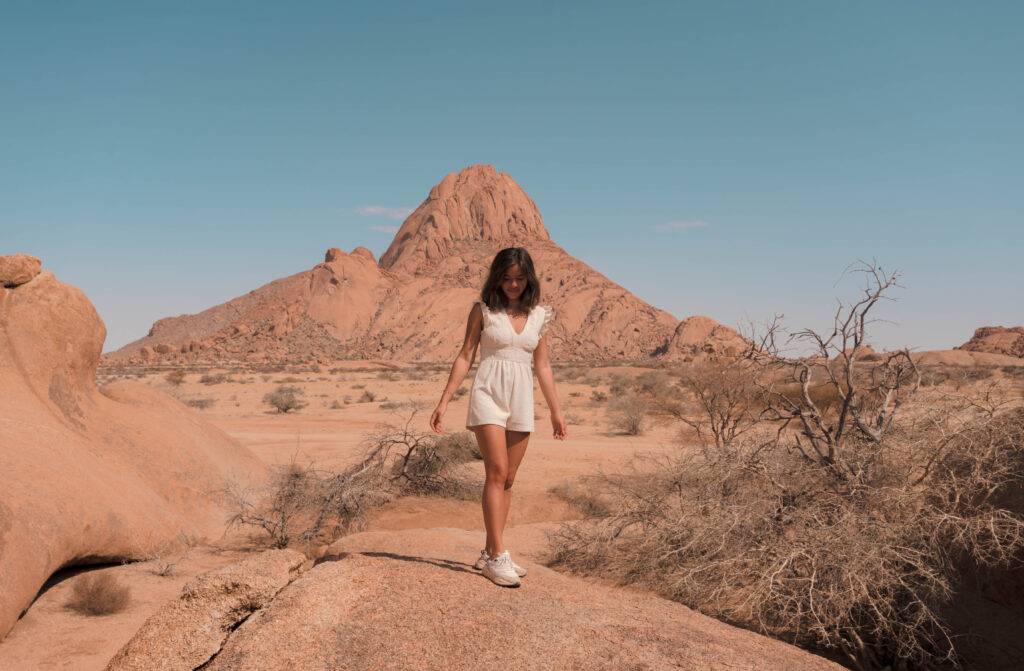
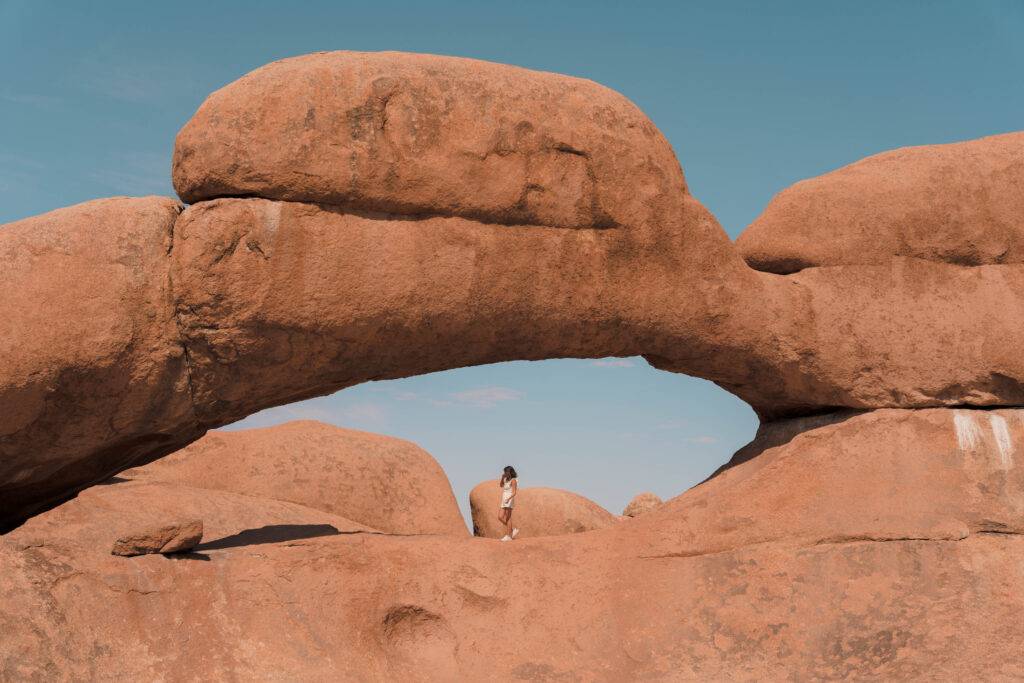
One of the places to visit in Spitzkoppe is the Rock Pools, which fill up with water when there’s enough rain. This wasn’t the case when I visited, so here’s a simulation using artificial intelligence to show you the potential.
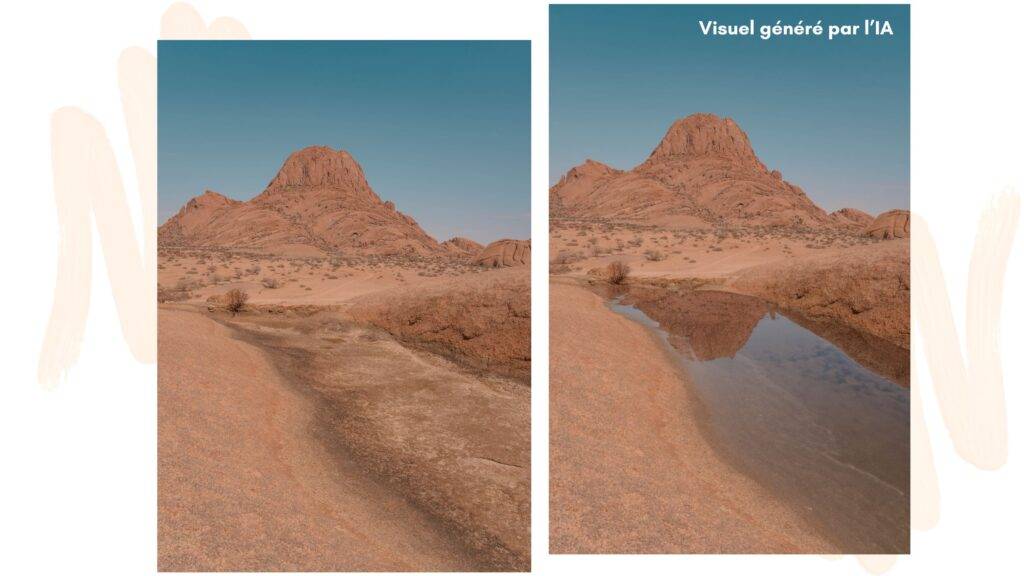
➡️ Road to the Atlantic coast
Allow around 2 hours drive from Spitzkoppe to reach the evening camp. On the way, you can enjoy splendid views of the Erongo Mountains. For a lunch stop, you can make a short diversions to the small town of Usakos, which was founded in the early 20th century during German colonisation. Alternatively, you can enjoy a picnic on the ocean side.

📍 Moon Landscape
For this afternoon, I highly recommend driving to the Moon Landscape National Park (the Valley of the Moon). This lunar environment is impressive, formed by erosion over thousands of years. There are several viewpoints on Google Maps. The landscape is all the more beautiful when the light is soft, as you can see the shadows gradually forming.
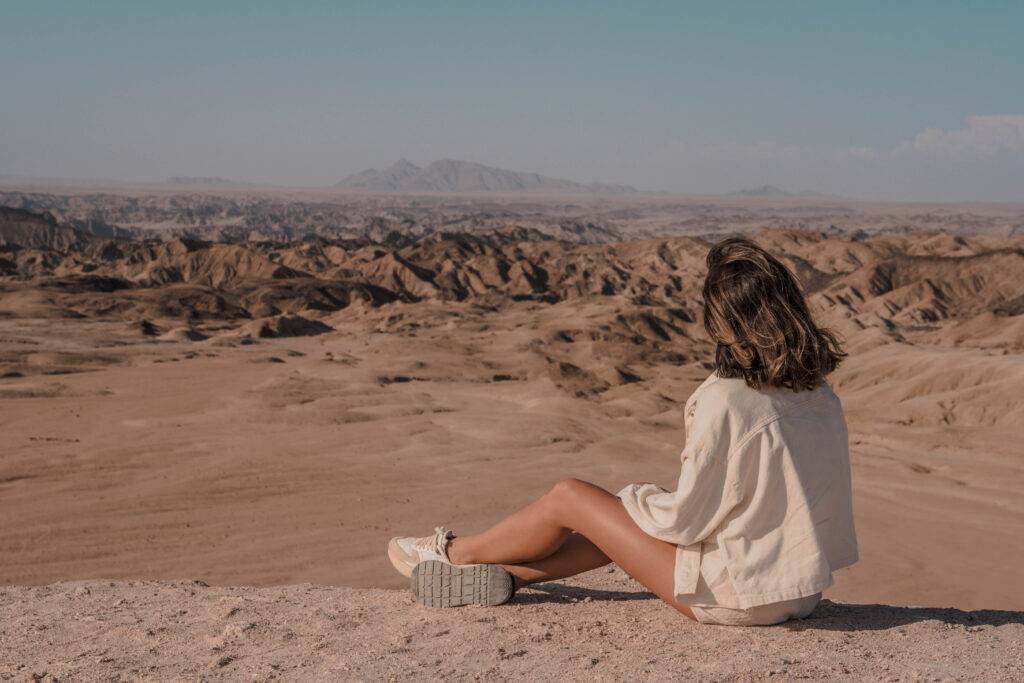
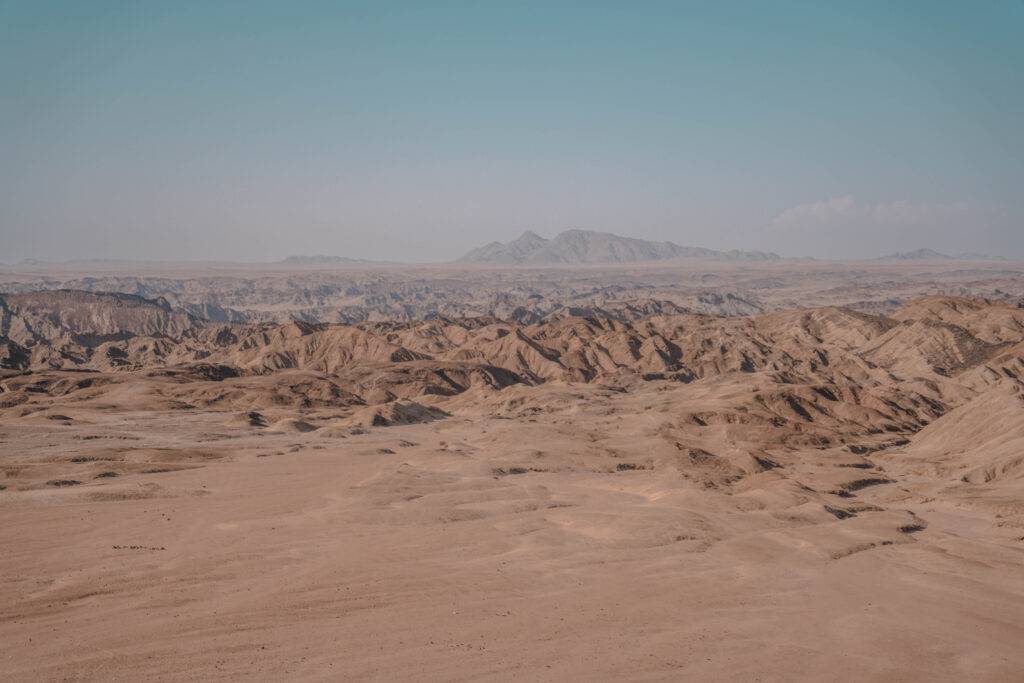

😴 Sleep with the melody of the waves
Tonight’s campsite is located in Swakopmund, a pretty town by the ocean. Here, you can take the opportunity to withdraw money from one of the banks and do some shopping. From the beach next to the campsite, we were able to admire a pretty sunset while having an aperitif. 🥰 There’s even a lovely bar for a drink on the beach.
Where to eat in Swakopmund ?
For dinner, we went to The Tug restaurant, which offers more refined cuisine with great service. The prices are a little higher but the quality is still reasonable. The boat-themed decor is very nice. The restaurant’s terrace overlooks the beach, so I’d recommend this place in a heartbeat.
The next morning, you’ll wake up very early if you’ve chosen to do a kayaking activity. For breakfast, go to the Village Café for a good coffee and a sweet to take away !
Day 8 : Kayaking with the sea lions
This morning will be both sporty and entertaining, as it’s time to go kayaking with the sea lions. I advise you not to miss this activity.
I’m not a big fan of kayaking and yet I loved it ! 🥰 During the morning, you can get very close to the colonies of sea lions on the beach. In fact, as sea lions have no predators in the water, they are not at all afraid of you if you arrive towards them in a kayak. On the other hand, if you’re on land, you really mustn’t get too close to the colony so as not to frighten them.
→ WARNING : Unfortunately, you’ll see a few dead animals here; the guides will explain that this is because there are too many sea lions, so some don’t survive. Incidentally, I STRONGLY advise against visiting the Cape Cross reserve further north as the number of dead sea lions is staggering. We didn’t know this before we went there, so we paid €15 entrance fee to see a macabre spectacle, coupled with an unbearable smell. Suffice to say, we quickly left after trying to save a baby sea lion that was dying in the middle of the road. Having said that, don’t worry, you can’t kayak here, and fortunately there are fewer deaths than at Cape Cross.
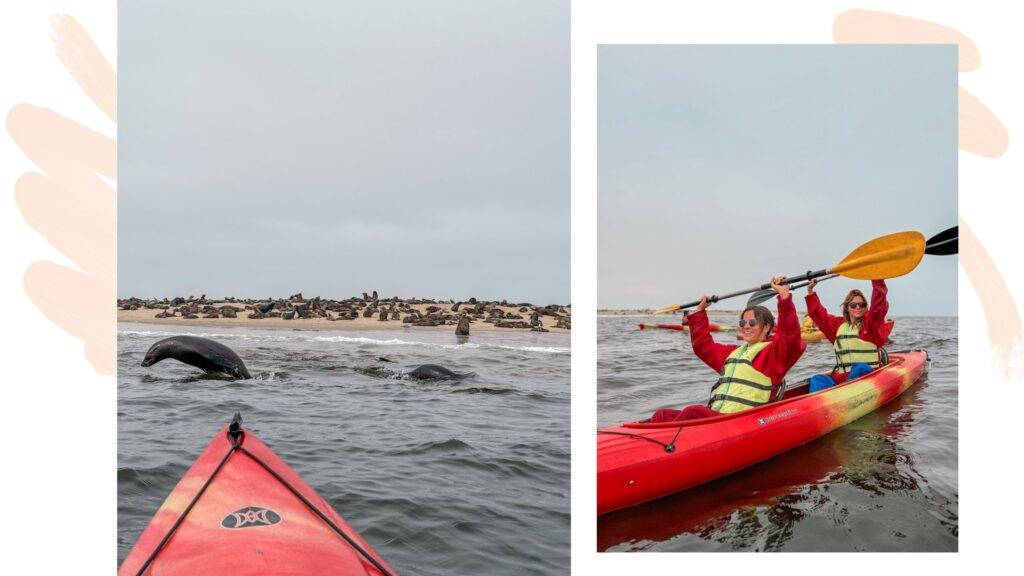
➡️ Road to Sesriem
After kayaking, if you’re hungry, I recommend a quick lunch in Walvis Bay. Don’t take too long to get back on the road, as it’s a 4-hour 15-minute drive and you should always arrive at the camp site before sunset. Most of the national parks close at dusk, and it’s very dangerous to drive at night in Namibia. I’ll tell you more in the practical information at the end of this article.
On the way, you’ll see the sign marking the Tropic of Capricorn, so stop for a souvenir photo. It’s not every day you get to cross this border ! You’ll also pass through the small town of Solitaire, with its legendary petrol station. Take the opportunity to try the delicious apple crumble at McGregor’s Bakery.

📍 Arrival in Sesriem
If you arrive around 4.30pm/5pm, you can take the opportunity to go on a one-hour walk through the heart of Sesriem Canyon. Simply ask for a map and information at the visitor centre, a guide is not compulsory.
This evening, you will sleep in the heart of the Namib Desert in Sesriem. There is a restaurant on site, but you can also build a fire at the campsite and prepare your own food on your pitch. Keep an eye out for the sunset, which is superb.
→ Access to the national park : €20 for 2 people for the 2 days.
Day 9 : Must-sees during your road trip in Namibia
Today you’ll be in for a real treat, with scenery that’s totally different from what you’ve seen so far on your road trip in Namibia. So far, you’ll have noticed that this destination is not very touristy, but today is the day you’ll see the most people. On the other hand, in my opinion, it’s still very uncrowded.
So let’s be brave and set the alarm for 4.15am sharp. That’s enough time to get dressed, fold your tent and brush your teeth, before hitting the road at precisely 4.30am to Dune 45 for sunrise. Don’t forget to bring plenty of water, sunglasses and a cap.
♥️ Sunrise over the Sossusvlei dunes
Yes, you’re going to suffer, yes, you’re going to curse me when you’re climbing the dune but… you’ll thank me afterwards (or not 😂). On a more serious note, I’d advise you without a shadow of a doubt to get up for this timeless experience. The climb up Dune 45 will take you 15-20 minutes depending on your pace, but it’s easily doable. Once you reach the summit, 170 metres high, you’ll be overwhelmed by the landscape before you.
Don’t worry, the descent is much more fun and easier !
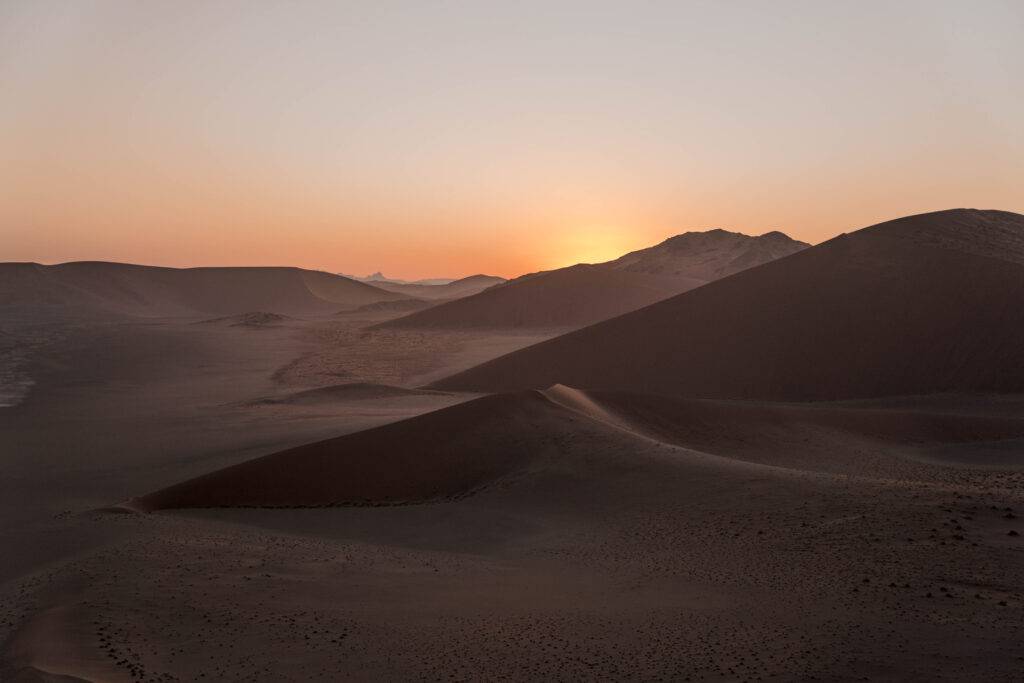
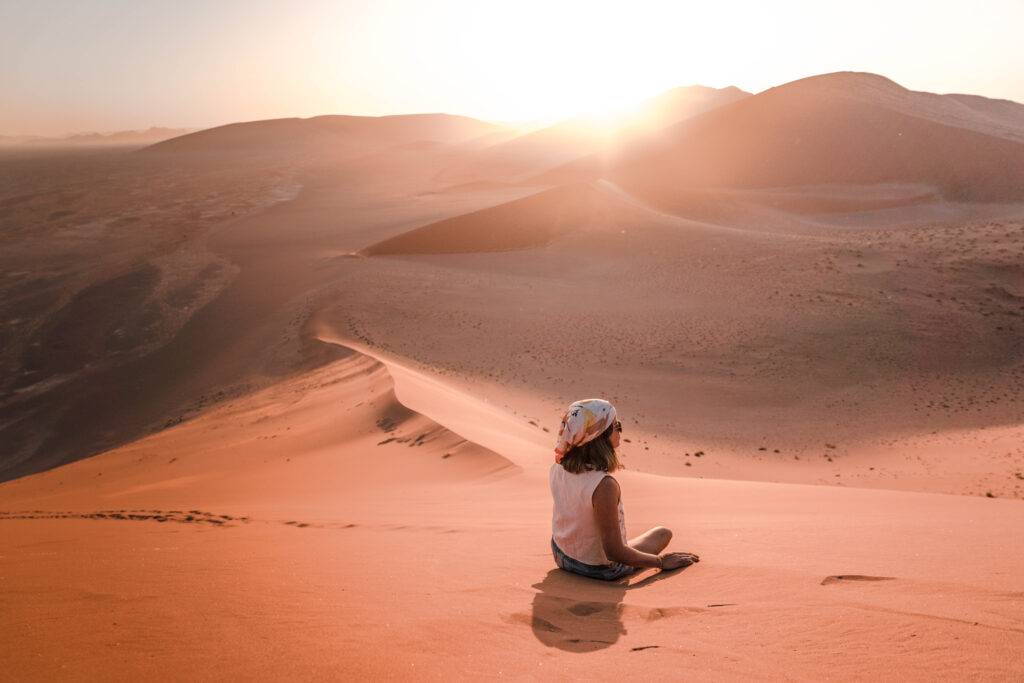
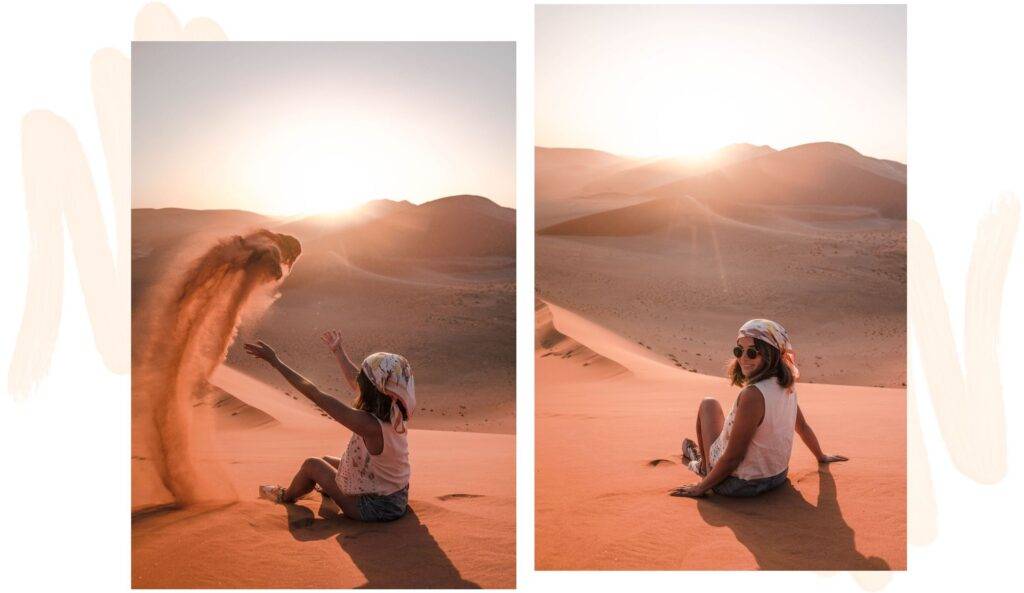
📍 Dead Vlei
Let’s continue the wonder with Namibia’s most famous place : the Dead Vlei dry swamp. I’ve seen a huge number of photos there, so I was afraid I’d be disappointed. Well, no, I found it magnificent, unique and incredible.
Dead Vlei means ‘dead swamp’. You might be wondering why acacia trees started growing in the middle of the desert only to dry up completely. To understand this, you have to go back almost 1,000 years. Dead Vlei is in fact a basin of salt and white clay that was once flooded by a river, allowing trees to grow. However, the dunes that gradually surrounded it blocked the inflow of water, causing the acacias to die. As it hardly ever rains in this region, the trunks dried out and did not rot thanks to the lack of moisture.

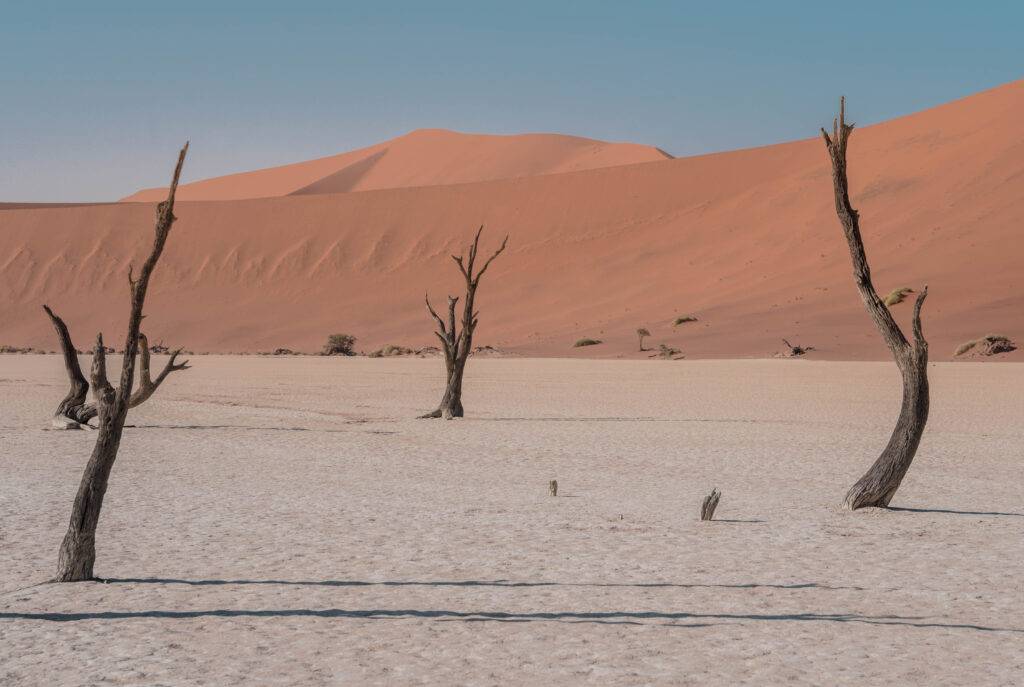
How do I get to Dead Vlei ?
You need to pay for the shuttle bus to take the 5km track to the start of the Dead Vlei trail. When you get to the end of the road, park and walk about 15-20 minutes to Deadvlei.
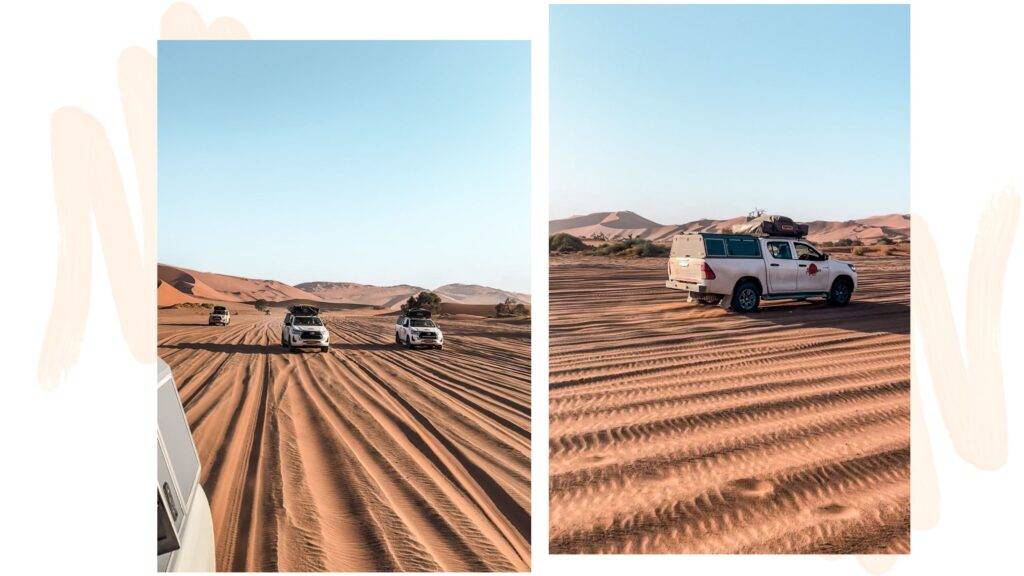
📍 Big Daddy, Big Mama
Did you know that Namibia is home to the highest dunes in the world ? Big Daddy is the huge dune you can see from Deadvlei. Many brave souls climb the dune, which reaches a height of 300 metres. Personally, I’d run out of juice in my legs and it was too hot, so I preferred to admire it from below.
Big Mama is another remarkable dune, measuring 200 metres high.
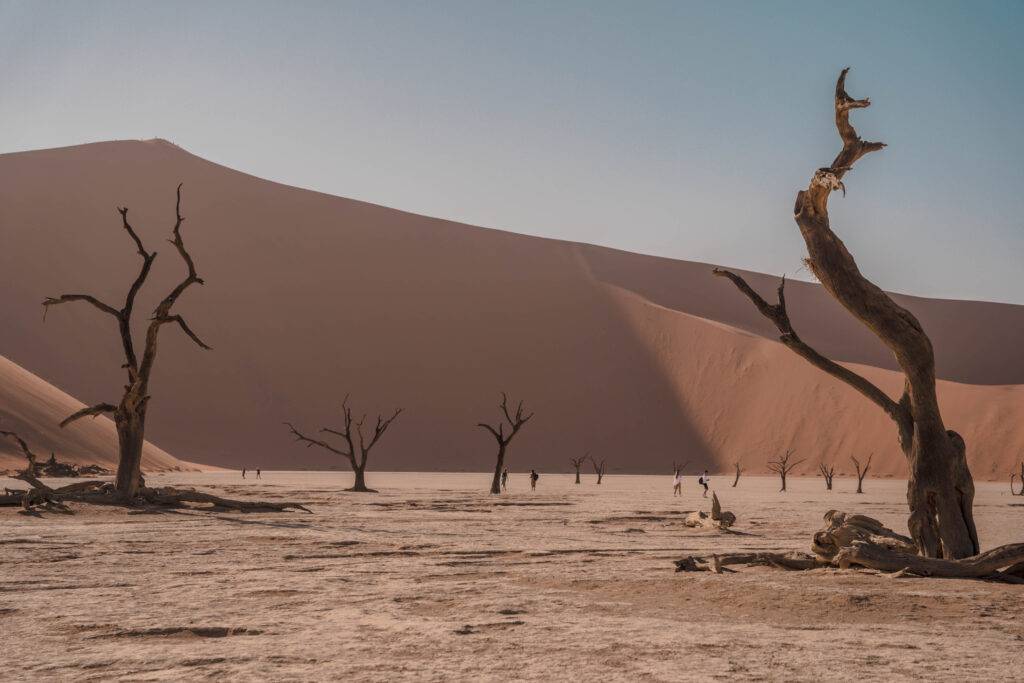
➡️ Relaxing afternoon and off to the last campsite
After this adventurous morning, the lazy me recommends that you relax by the pool at the campsite where you slept the night before. Once you’ve rested your little eyes, you can enjoy the hour’s drive to the next and last (😭) campsite, located in Naukluft.
I’ll never forget this place, because it’s where we punctured our tyre, right in the middle of the nature reserve, a few kilometres from the campsite reception. It was a very funny incident in retrospect. Imagine the scene : two 1.60m tall girls struggling with the spare wheel and jack for 1 hour, afraid that a lion was going to eat us (note : there are no lions in Naukluft but hey… we’re drama queens). In the end, we made it !
Anyway, from what I hear, puncturing a tyre is a rite of passage in Namibia, so check out some tutorials before you go… 😂
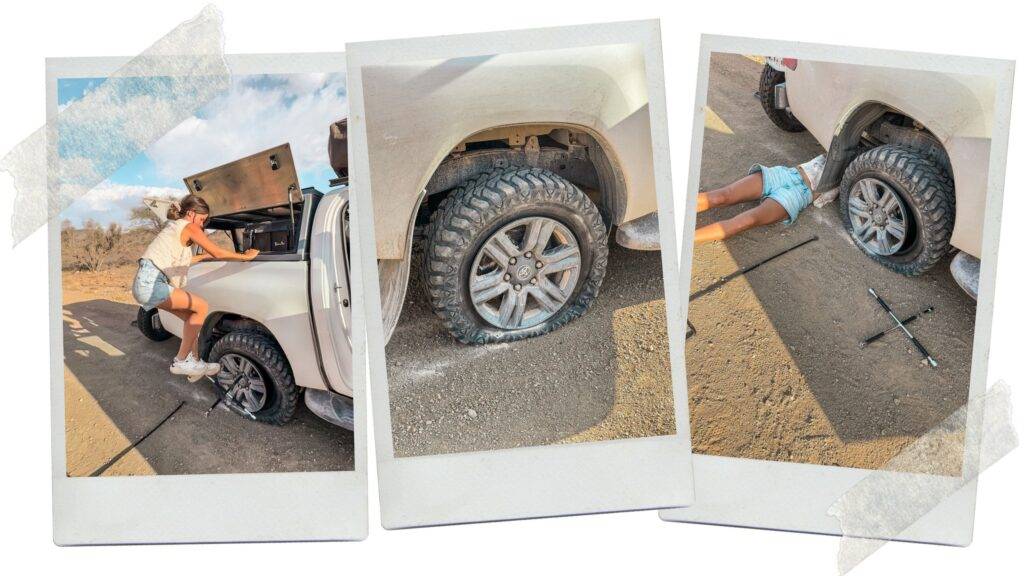
Day 10 : Naukluft Mountain Zebra Park
→ Access : 300 Namibian dollars for 2 (≈ 18€)
So for the last night, you’ll have slept in at the Naukluft Park campsite. You’re sure to be woken very early by the baboons who come to rummage through the rubbish bins and steal the campers’ breakfast. So it’ll be a rather unusual last wake-up call in a tent !
This nature reserve is home to mountain zebra, baboons and leopards (although these are very, very rare). You can visit it by car but also go hiking.
📍 Natural pools at Naukluft
At reception, the ranger will give you a park of the nature reserve and directions for the hike leading to the natural pools. It’s a walk of around 3km without much difficulty. I advise you to start around 8am to avoid getting too hot and to have time to enjoy a swim before heading back to Windoek.
You’ll have the chance to swim alongside baboons, in the middle of nature, in crystal-clear, cool blue water. A real paradise, unusual and unexpected in the heart of Namibia. 😍
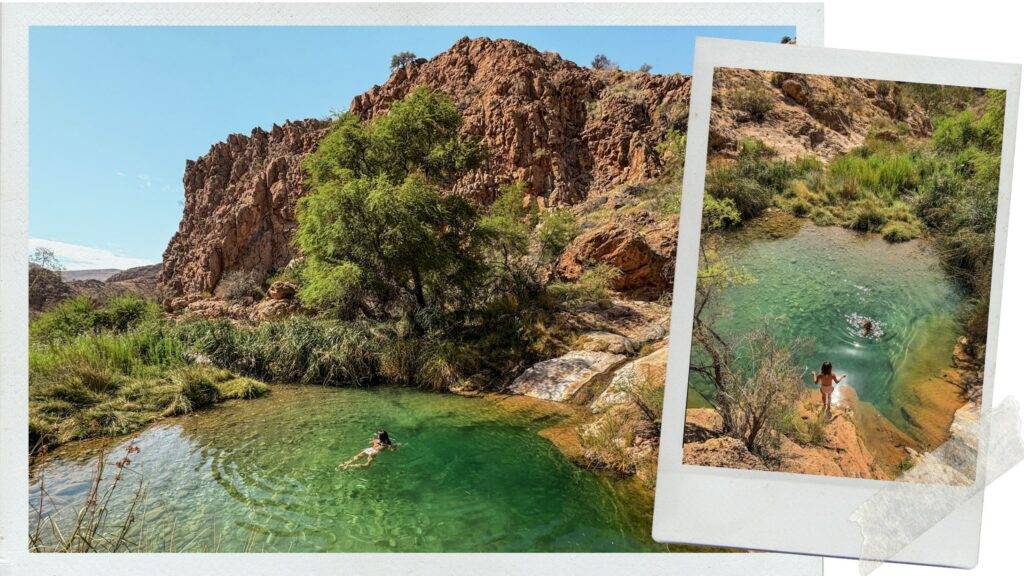
End of the road trip in Namibia : back to Windoek
On your last day, it’s time to get back on the road to the capital. You’ll have to return the car at 4pm, so be careful with your timing ! For the last night, you can rest before taking the plane in a beautiful hotel in Windoek, the Roof of Africa Hotel.
So that’s the end of the Namibia road trip itinerary. I hope I’ve helped you organise your trip to this exceptional country. Don’t hesitate if you have any questions : use the comment section on the blog at the bottom of the page.
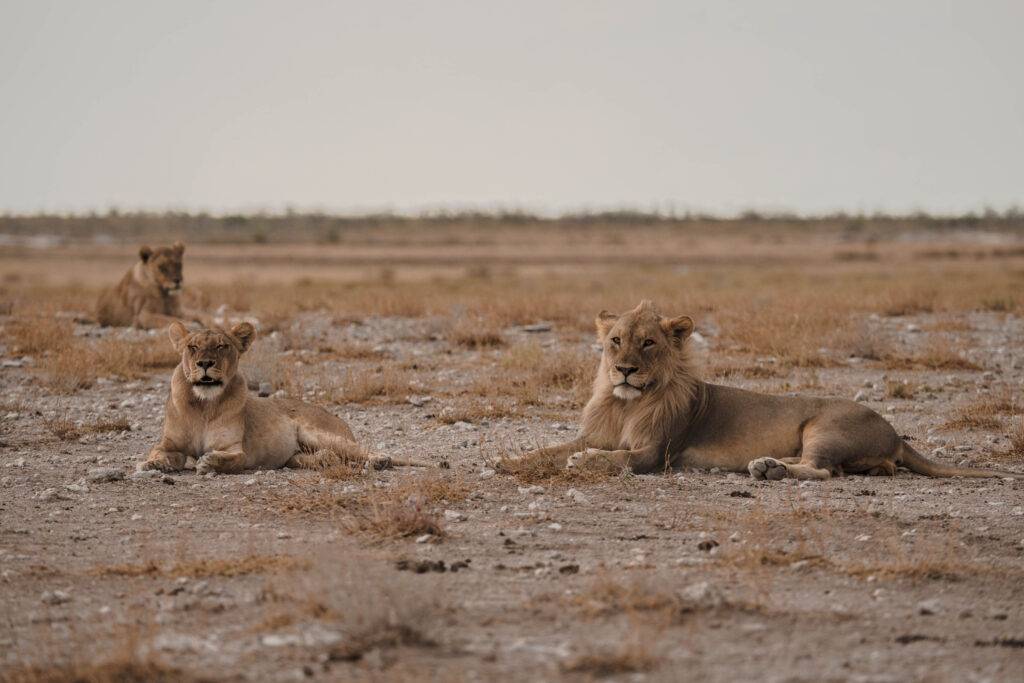 Road Trip in Namibia : Practical information
Road Trip in Namibia : Practical information
☀️ When should you travel to Namibia ?
You can travel to Namibia all year round. There are 2 seasons : the southern winter, from May to November (dry season) and the summer (rainy season) for the rest of the year. The peak of the rainy season is between January and March. That said, it is very marked in the north of the country, but it hardly rains at all in desert areas such as the Namib. In winter, the temperature difference between day and night is high, with possible frosts in the desert.
I decided to go in November and despite some intermittent rain at the start of the trip, the weather and temperatures were ideal ! The advantage of these dates is that they’re outside the peak tourist season, which means you can enjoy the scenery with very few people !
What language is spoken in Namibia ?
English has been the official language of Namibia since 1990. However, it is not the mother tongue of the majority of the population. Half the population speaks Oshiwanbo, and other Southern African and Germanic languages are also spoken. Yes, because Namibia was a German colony from 1884 until the Treaty of Versailles in 1919 forced the Germans to abandon the occupied territories. The country was then placed under a mandate from South Africa, before finally gaining its independence in 1988.
To conclude this little history lesson, English is all you need to travel around Namibia !
Do I need a visa to travel to Namibia ?
The Namibia government permits citizens of specific countries to travel and explore Namibia for tourists or official business purposes. For all visitors of Namibia, it is not mandatory to have a tourist visa for visits of less than ninety days for countries including in the list. But it is strictly stated by the Namibia visa policy that the person should hold an ordinary service passport to avail of this feature in Namibia.
Driving in Namibia
First, be aware that the international license is normally required to drive in Namibia. But this is only valid if you are controlled by the police. The car rental company will simply take your national driving licence. I didn’t have time to get my international license, so I asked for an English translation of my driving license on this website in case of police check.
Secondly, note that you drive on the left with the steering wheel on the right in Namibia. I was quite panicked at the idea of driving backwards before leaving, but finally we get used to it very quickly. The first steps behind the wheel are easy because you will leave Windoek, so there will be enough traffic in the city to follow the cars in front of you. I just had trouble with the turn signals and the inverted wipers 😂 but nothing serious !
Finally, don’t drive when night has fallen. This can be very dangerous and in any case, you will not be covered by the insurance in case of accident. If you follow my itinerary, you won’t have to worry about timing.
What is the budget for an 11 days itinerary in Namibia ?
Namibia Trip : Budget for an 11 days road trip
Here are the details of my expenses :
- Rental of the 4×4 with tent on the roof, all the camping equipment, the route + campsites/ hotels : 1200€ per person
- Petrol : 350€
- Food : 310 € for 2 people for the whole stay with groceries and some restaurants, ie 14 € per day/ person
- Flight : from 700€ per person
- SIM card : 15€ per person
- Park entrances : about 70€ for 2
Budget for 11 days of road trip in Namibia : € 2,280 per person, excluding safari/ kayak activities.
Road trip in Namibia : others informations
The currency in Namibia
The local currency is the Namibian dollar (NAD). Use a conversion app or Google for equivalents. Roughly, 100 NAD = €5 to date.
I advise you to bring euros to change them on site or withdraw in a Namibian bank if you have a free credit card abroad. Prefer distributors of official banks to pay less withdrawal fees.
❗️Is Namibia a safe country ? Can we travel alone, with women or with children ?
I tell you a big YES. We felt very safe in Namibia. The locals are adorable (with a few exceptions as always) and at no time did we feel uncomfortable. Just avoid walking around the capital Windoek, there is not much to see and it is the only place where men were asking us for money in a somewhat aggressive way.
My experience in Namibia
What surprised me the most in Namibia is the cleanliness of the country. There is no waste on the roadside and it’s super nice! The government has a very strict policy on plastic in particular and is doing everything possible to preserve its fauna and flora. 👏
As you can see, I had an extraordinary trip for several reasons. One of them is the beauty and diversity of the landscapes, which can be enjoyed with very few tourists. However, it is an adventure stay so when you spend 8 nights in a tent, you should not expect a quiet holiday with maximum comfort! I still slept very well and we can of course shower every day which is appreciated.
How to dress for a trip to Namibia ?
The answer is simple : as you wish.
Bring swimsuits, summer clothes but also a windbreaker and a sweater for the part of the route near the ocean. Indeed, on the coast, temperatures drop around 15 / 20°C. Do not forget to take a cap or hat for desert regions !
How to have internet on your phone ?
You can purchase a local SIM card from MTC at Windoek Airport upon arrival. Just take some internet data, because you won’t necessarily need to call.
To dream elsewhere…
This article contains affiliate links. If we helped you organize your trip or you just want to support us, consider booking your stay in Namibia by clicking on our links. We will receive a small commission and the price remains unchanged for you of course. 🤍

Je suis Aurélie, co-créatrice du blog et de l’Instagram Amoureux du Monde. Depuis 2016, j’ai eu la chance de visiter de nombreuses destinations et de me former à la photographie via ces expériences. Ce que je recherche en voyage, c’est l’apaisement devant un magnifique paysage, l’émerveillement devant la beauté de la nature et l’émotion devant un coucher de soleil.


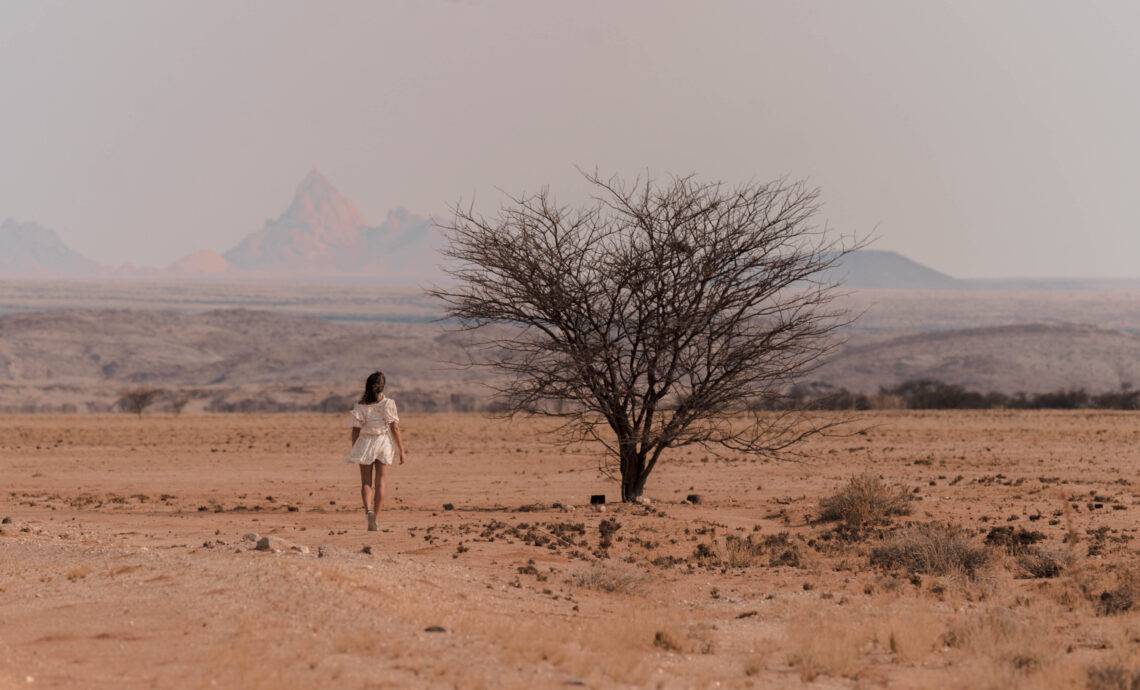

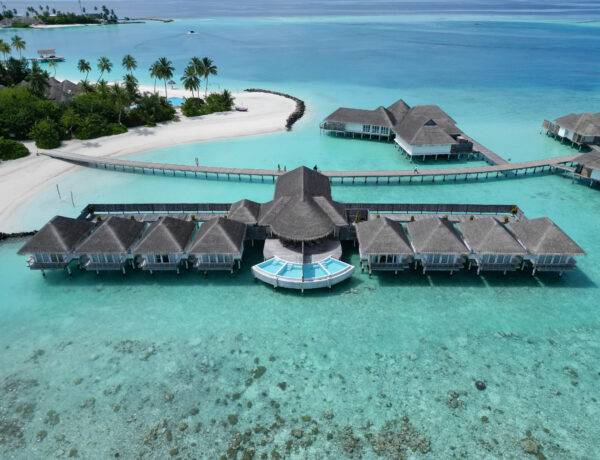

No Comments